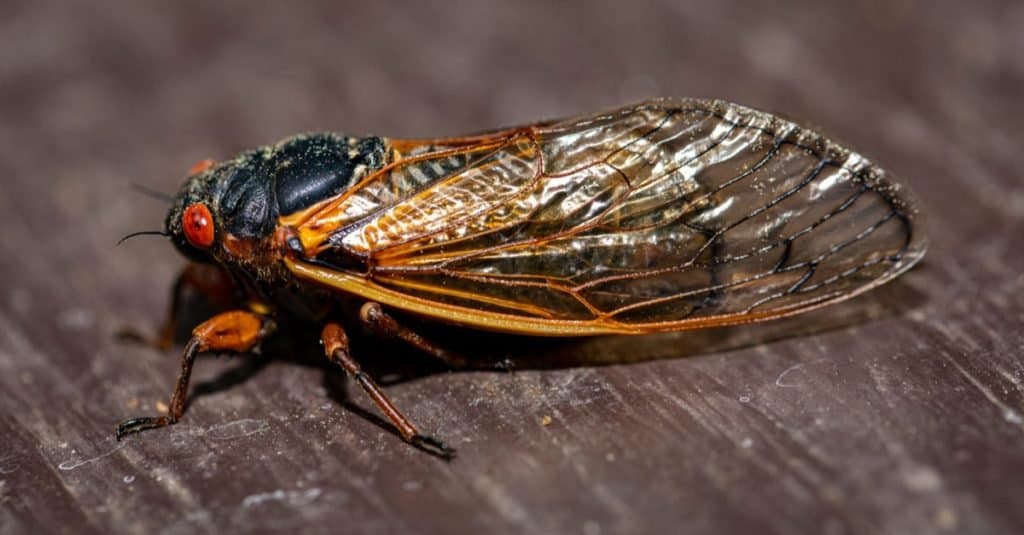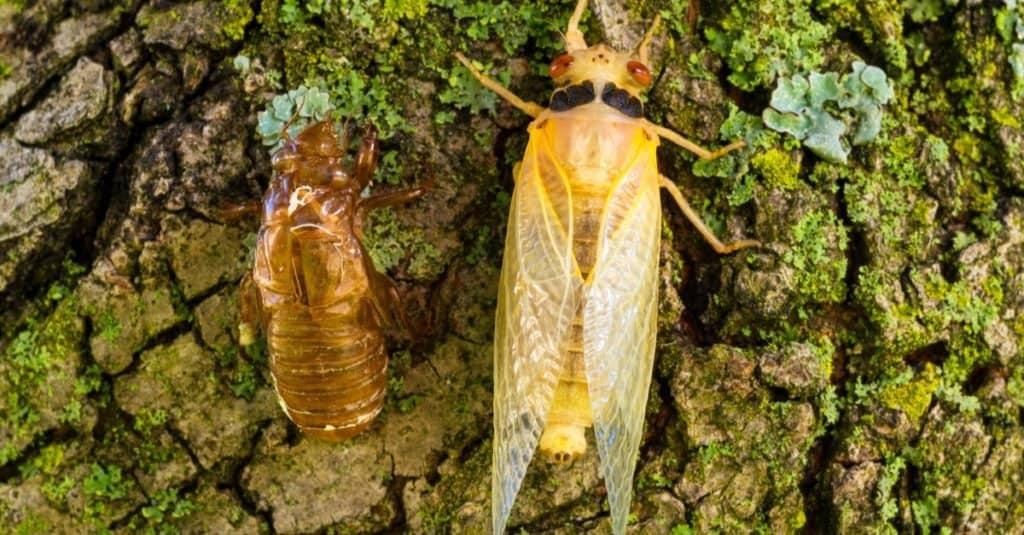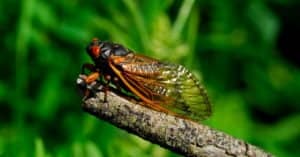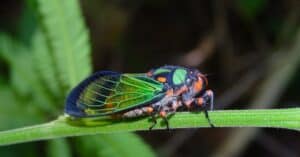If you live in the eastern part of the United States, you’ve probably heard a lot of news about Brood X 2021 and Cicadas recently. Given the odd, red-eyed appearance of the periodical type of this insect, and because they are sometimes erroneously referred to as Locusts, it is not surprising that you may wonder whether these bugs are a cause for worry.
Are Cicadas the same as Locusts?
The short answer is no, Locusts and Cicadas are not the same. A Cicada is much more similar to an aphid than a Locust, and a Locust is a type of swarming grasshopper. For a longer answer, read our post all about the differences between these two types of bugs. They both get their sustenance from plants, and they are both insects who show up in large numbers, but there are not many more similarities.
Are Cicadas a cause for concern?

Side view of Brood IX 17 year cicada, highlighting translucent wing structure
©Charlie Floyd/Shutterstock.com
The Brood X Cicadas are coming in 2021, but there is really very little cause for alarm. In fact, a lot of animals will be very happy at the feast these plentiful insects will provide. So please don’t use insecticides to get rid of the Cicadas! You could hurt a lot of animals in the process. If you’re still worried, keep reading. Maybe learning more about them will help calm your fears about these strange invaders from underground.
One important thing to remember is that, unlike Locust swarms, Brood X will not destroy crops. If you are not near any location where they are emerging in 2021, they should be of no concern at all to you. It is possible a few of the bugs could hitch a ride outside their main breeding grounds, but given how little these insects have spread across the United States map to date, this is unlikely to happen in significant numbers. The National Forest Service actually does have an app where you can report seeing any Cicadas outside the expected areas, so if you see them, you can let them know.
These insects do feed off of plants, but they drink the liquids from inside the plants, rather than eating the leaves. Most well-established plants can handle this easily, so the biggest threat from the large groups of these bugs is to young and newly planted vegetation, and there are many steps you can take to protect those plants, the easiest being to cover smaller plants with plastic or gently spray the bugs off with a hose if they are already trying to feed on it.
Cicadas don’t bite humans either, just plants, so unless you have a phobia of bugs, there really isn’t much cause to be alarmed. If you are in a location that is expecting a high population of the bugs in 2021, and you are afraid of the insects landing on you, consider purchasing some disposable ponchos and a cheap umbrella.
Fair warning, though, if you have sensitive ears, you should be aware that male mating calls can reach up to 100 decibels! Unlike most insects, the males don’t rub body parts together to make their sounds. The males have two tymbals which are a lot like the skin on a drum head, and they vibrate these to make their mating call. That call then resonates through their hollow bodies. Male Cicadas are a lot like little drums with wings!
What does “Brood X” mean?
Cicada groups have been named “broods” and then lettered according to their life cycle. “Brood X” merely refers to the brood of Cicadas that will emerge aboveground in 2021. Brood X is a 17 year perennial. What that means is, after the eggs they lay hatch out, the resulting nymphs will burrow into the ground and stay there, feeding on roots, for 17 years before emerging above ground once more.
Where will the Cicadas be in 2021?
Brood X Cicadas will be appearing primarily in the northeastern United States in 2021. They will emerge over most of the state of Indiana, the middle section of Ohio, the middle of New Jersey, all of Delaware, the majority of Maryland, much of southeastern Pennsylvania, and also a significant section of eastern Tennessee. There are a few isolated spots in small areas of Illinois, Michigan, Virginia, West Virginia, North Carolina, New York, and Georgia where they are also expected to be seen, based on prior sightings. These perennial bugs will also be found in the District of Columbia. They should not venture much beyond these areas. This map shows the approximate location of Brood X as well as the location of all the other broods. The map also tells the years each brood will come out. Another map shows only the locations of Brood X.
When will the Cicadas come out in 2021?
Brood X will be emerging during the spring and summer of 2021, but when you might start to see them depends on which part of the United States you are in. Brood X were expected to come above ground around March of 2021 for some southern states, so they may have already started emerging in places like Georgia and parts of Tennessee. They begin to move toward the air and out of the ground when the temperature reaches around 64 degrees Fahrenheit at about eight inches below the surface of the ground. Toward the end of May 2021, most of the Brood X bugs in the eastern United States will have started to come above ground. In more northern locations, it may be as late as June. You will know they are coming when you see small holes start to appear in the ground around trees. Unlike many insects, Cicadas do not pupate between growth stages, they molt, shedding their outer skin. Because of this, it is possible you might begin to see the brown bug-shaped husks left over from the molting process stuck to trees, even before you see the insects themselves.
How long will Cicadas stay in 2021?

A teneral adult seventeen-year cicada, newly molted, rests on a tree next to a cicada shell.
©Kenneth Sponsler/Shutterstock.com
Though it can live for many years below the ground, a Cicada only lives for about six weeks or so once it comes up to feed and lay the new batch of eggs. The burrowed insects may not all come above the ground at exactly the same time in each location, and some may live slightly longer than six weeks, so it is possible that some areas will see groups of these insects for close to two months.
How many Brood X are coming in 2021?
It is hard to know the exact number, but it is estimated that near the end of May 2021, the population density of Brood X above the ground in each location is expected to reach anywhere from tens of thousands to about one and a half million insects per acre. Locations with only isolated areas of emergence are unlikely to see the higher numbers, but for places where the map above shows a lot of yellow, Cicada numbers will probably reach the millions.
To sum up, in 2021 some locations will see millions of the flying insects known as perennial Cicadas. They are not harmful to humans, as they generally don’t bite and have no toxin or venom. They are only harmful to animals if they have been sprayed with pesticides. Otherwise, many animals will have a nice feast in the spring and summer of 2021. They typically only cause harm to small, young plants, and those can easily be protected. Once they come out, they will be gone again in about six to eight weeks. Brood X is no cause for alarm.
Update on the 2021 Brood X
To recap what actually became of the Brood X frenzy, they emerged in April and were gone by the end of June, leaving a legacy of noise, mating, reproduction, death, food for other animals, and media excitement. An app called Cicada Safari helped researchers and average US citizens track encounters with Brood X. In total, over 196,000 people downloaded the app, and shared over 560,000 photographs and 28,000 videos. It’s safe to surmise that this Brood made history as the most documented of all time. Here’s a fun look at what happened when the Brood X cicadas emerged with interesting film footage.
Cicada FAQs (Frequently Asked Questions)
Cicada Brood X News & Information
Brood X is currently (spring 2021) emerging on the east coast of the United States. More information and coverage can be found here!
- Cicadas in New York: What’s Happening Now?
- Cicadas in Pennsylvania: What’s Happening Now?
- Cicadas in Virginia: What’s Happening Now?
- Cicadas in Tennessee: What’s Happening Now?
- Cicadas in Washington, DC: What’s Happening Now?
- Cicadas in Maryland: What’s Happening Now?
- Here’s What 1.5 Million Cicadas Looks Like
- Will Cicadas Cause More Snakes? Copperheads?
- Can Dogs Eat Cicadas?
- Will Cicadas Eat My Tomato Plants?
- Cicada Brood X 2021: What is it and should you be concerned?
- Why Do Cicadas Only Come Out Every 17 Years?
- Cicadas vs Locusts: What’s The Difference?
Up Next…
- Ladybug vs Japanese Beetle: What are the Differences? How does the ladybug compare to the Japanese beetle? Learn more in this fascinating read.
- Cicadas Lifespan: How Long Do Cicadas Live? Find out more about the amazing life span of the cicada in this article.
- Are Insects Animals? Ever wondered if insects are technically classified as animals or not? Let’s dive into the topic and answer that question.
The photo featured at the top of this post is © Chris Alcock/Shutterstock.com
Thank you for reading! Have some feedback for us? Contact the AZ Animals editorial team.





